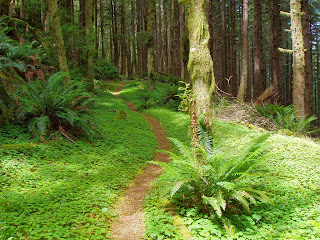Cumulative mileage
figures in parentheses refer to mileage in this section only.
Notations such as “(Hike 109)” refer to hikes in my book Day
Hiking: Oregon Coast.
Let me know about your OCT journey, especially anything that contradicts or adds to the information in this blog. I will happily share it with other hikers.
For details of the trail south from Secret Beach, see Hikes 109, 111, 112, 114, 115, and 116, approximately 12 miles (but it might be a little longer; I need to recheck those mileage figures). The route is not always clear, due to spur trails, etc., but you won't get lost. A southern trail extension has been added to what I wrote in Day Hiking: Oregon Coast. At Lone Ranch Beach, continue down the beach 0.5 mile, crossing first one creek and then a second at the base of the headland where the beach ends. Here look for a trail up the headland and then east, where it tunnels into the trees. It emerges for a distance, then dives back into forest to wind to the highway (0.7 mile from the beach). Walk the highway shoulder 2.3 miles to Harris Beach State Park (15.5 miles).

To continue to the California border from Harris Beach,
follow a paved bike path out of the park for 0.4 mile, then continue on highway
shoulder and sidewalk along U.S. 101 for 2.1 miles, crossing the Chetco River
Bridge. At the south end of the bridge, turn right onto Lower Harbor Road and
follow it 1 mile, to where it rises and turns left; here, make a sharp right
onto Oceanview Drive (19 miles).
Follow Oceanview Drive 2.2 miles to the entrance to McVay Rock State Recreation Site, which has toilets (I don't recall if it has potable water). Walk west 0.2 mile to the beach. Ideally get here at low-ish tide, both to get around the rocks on the shore (I did some scrambling) and to wade the Winchuck River, 1.5 miles to the south. I arrived at high tide, so I followed the north shore to a little trail to a parking area near the highway, crossed on the highway bridge, and returned to the beach.
Follow Oceanview Drive 2.2 miles to the entrance to McVay Rock State Recreation Site, which has toilets (I don't recall if it has potable water). Walk west 0.2 mile to the beach. Ideally get here at low-ish tide, both to get around the rocks on the shore (I did some scrambling) and to wade the Winchuck River, 1.5 miles to the south. I arrived at high tide, so I followed the north shore to a little trail to a parking area near the highway, crossed on the highway bridge, and returned to the beach.
The California state line is
about 0.5 mile south of the Winchuck River by road or beach (23.4 miles). Nothing
marks it on the beach, but it's just south of Crissey Field State Recreation
Site, a "welcome center" that opened in December 2008. It represents
the official end of the Oregon Coast Trail—though, oddly, there was absolutely
no information about the OCT there when I arrived in July 2009; the volunteers
on duty didn’t seem to know much about it. I didn’t expect a brass band, but after 390.5
miles, a little lapel pin or commemorative fabric patch—even a trail register for
successful OCT completers to sign their names—would be nice!
WHERE TO SLEEP: There's no lodging in the vicinity of Pistol River; the first accommodations south of Gold Beach are the cottages at Whaleshead Beach Resort (www.whalesheadresort.com), which is basically a large RV park (tent campers not allowed). It's not strictly legal, but OCT hikers have pitched tents at Miner Creek Beach and China Beach in Boardman park. Harris Beach Sate Park at the north end of Brookings has a hiker-biker camp, and it's a fairly short walk from the park to the nearest grocery (1 mile?). There's lots of lodging in Brookings (www.brookingsor.com).






































